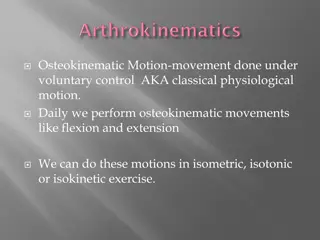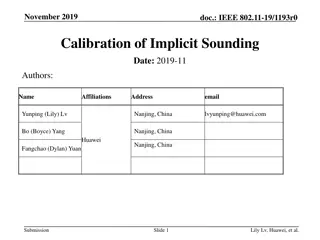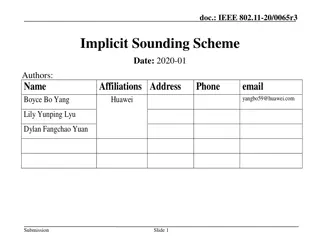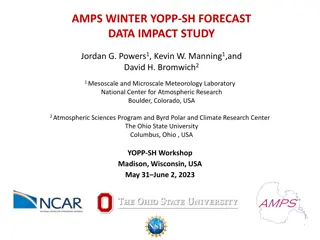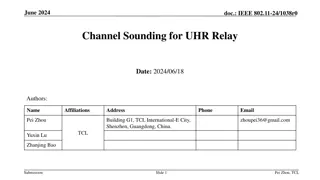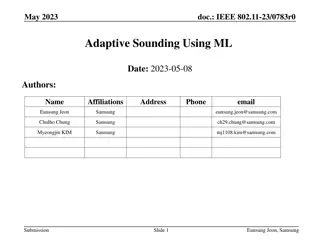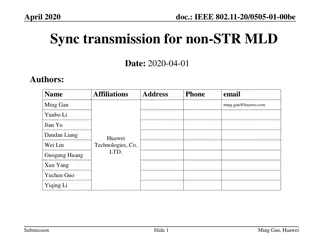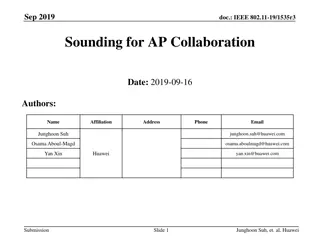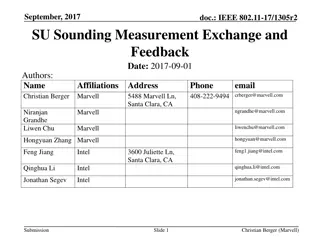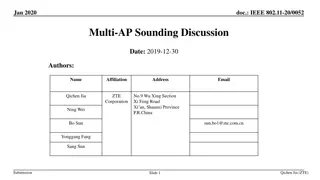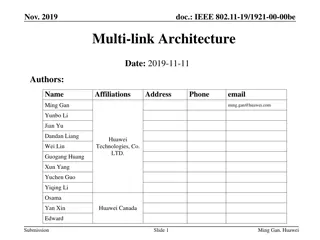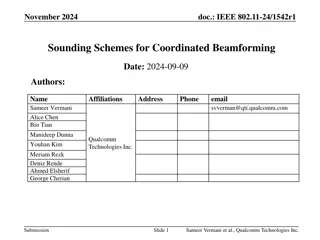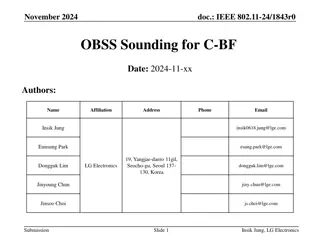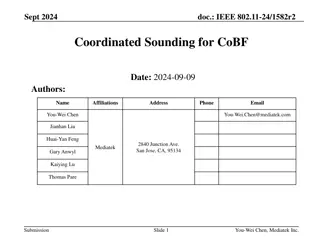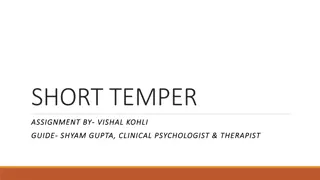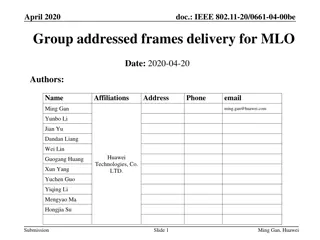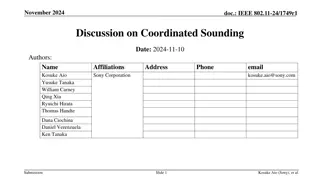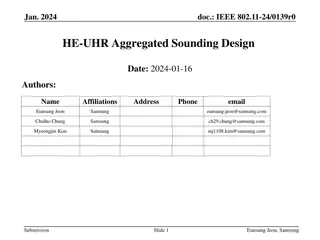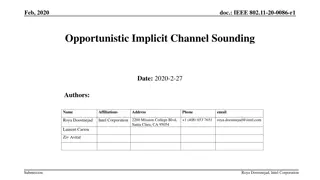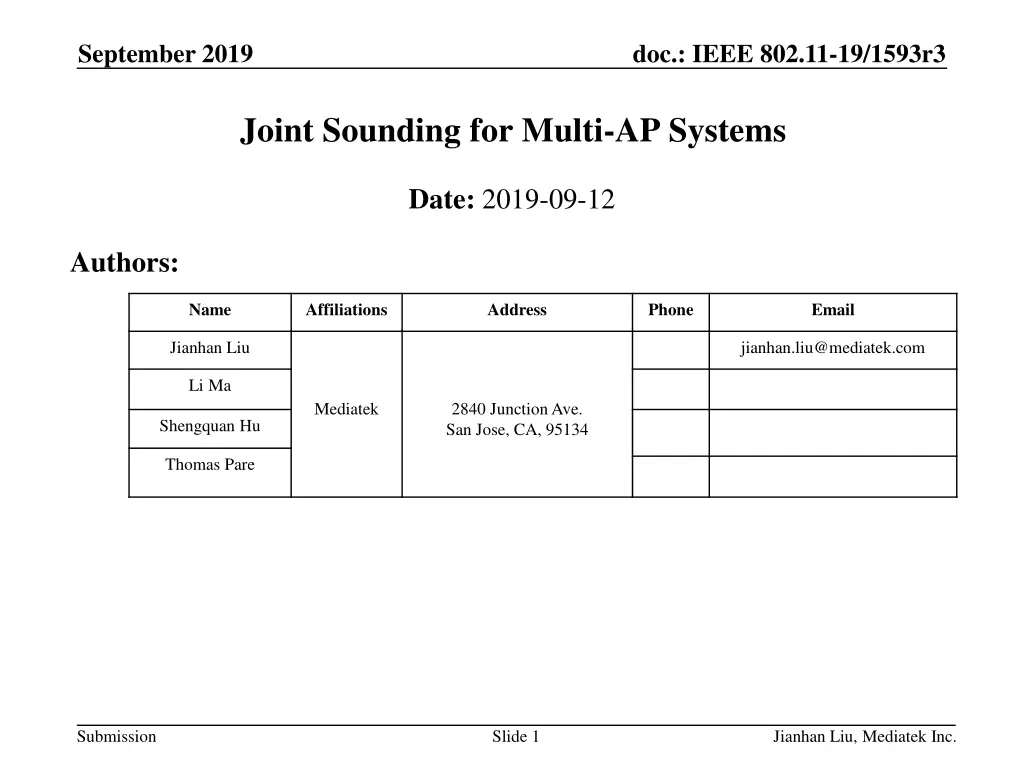
Multi-AP Systems Channel Sounding Options Analysis
Explore the different channel sounding schemes for multi-AP systems, including sequential channel sounding and joint channel sounding. Understand the implications and efficiencies of each method for IEEE 802.11 standards. Delve into the complexities of implicit and explicit sounding and the need for calibration accuracy in multi-AP environments.
Download Presentation

Please find below an Image/Link to download the presentation.
The content on the website is provided AS IS for your information and personal use only. It may not be sold, licensed, or shared on other websites without obtaining consent from the author. If you encounter any issues during the download, it is possible that the publisher has removed the file from their server.
You are allowed to download the files provided on this website for personal or commercial use, subject to the condition that they are used lawfully. All files are the property of their respective owners.
The content on the website is provided AS IS for your information and personal use only. It may not be sold, licensed, or shared on other websites without obtaining consent from the author.
E N D
Presentation Transcript
September 2019 doc.: IEEE 802.11-19/1593r3 Joint Sounding for Multi-AP Systems Date: 2019-09-12 Authors: Name Affiliations Address Phone Email Jianhan Liu jianhan.liu@mediatek.com Li Ma Mediatek 2840 Junction Ave. San Jose, CA, 95134 Shengquan Hu Thomas Pare Submission Slide 1 Jianhan Liu, Mediatek Inc.
September 2019 doc.: IEEE 802.11-19/1593r3 Channel Sounding for Multi-AP systems Spatial nulling, coordinated OFDMA and SU beamforming all required channel state information (CSI) available at the transmitter. Implicit sounding can not completely replace the explicit channel sounding in 11be For example, for MU-MIMO (from a single AP), implicit sounding quality may not be good enough. Implicit sounding requires calibrations. Calibration accuracy is up to each vendor. We investigate the different channel sounding schemes for multi-AP systems. Submission Slide 2 Jianhan Liu, Mediatek Inc.
September 2019 doc.: IEEE 802.11-19/1593r3 Option 1: Sequential channel sounding Sequential channel sounding: Based on single AP sounding Each AP performs channel sounding separately, similar to the single AP sounding in 11ax. Given the fact that 11be shall have the single AP sounding protocol, there is no way to disallow sequential channel sounding for multi-AP systems. Two Major Issues: Sequential channel sounding suffers efficiency degradation compared to other Joint sounding schemes for multi-AP systems. Sequential channel sounding can not enable joint transmissions because each STA only feedbacks the compressed V matrix between each AP and itself. Submission Slide 3 Jianhan Liu, Mediatek Inc.
September 2019 doc.: IEEE 802.11-19/1593r3 Option 2: Joint channel sounding 1. 2. 3. The coordinate AP initiates the Joint sounding. The sounding APs send out sounding packet simultaneously. The sounded STAs feedbacks CSI. Sounding Trigger Coordinate AP Sounding AP 2 Joint Sounding Packet Sounding AP 3 Sounding Feedback Sounded STA 1 Sounding Feedback Sounded STA 2 time The above is just an example, the detailed sounding procedure is TBD. Submission Slide 4 Jianhan Liu, Mediatek Inc.
September 2019 doc.: IEEE 802.11-19/1593r3 Option 2a: 11ax-like LTFs Global Antenna Indexing: For example, as shown in the following figure, there are two sounding APs: AP 2 with N2 antennas and AP 3 with N3 antennas. AP 3 AP 2 Local Antenna Index: N3 1 1 N2 . . . . . . Global Antenna Index: N2+1 N2+N3 N2 1 11ax-like LTFs: All sounding APs send LTFs by regarding its own antennas as a subset of all antennas from all sounding Aps Preamble STFs Joint Stacked LTFs . . . . . . LTF 1 LTF N2 LTF N2+1 LTF N2+N3 Submission Slide 5 Jianhan Liu, Mediatek Inc.
September 2019 doc.: IEEE 802.11-19/1593r3 Option 2a: 11ax-like LTFs (continues) Each non-pilot subcarrier of the Stacked LTFs are multiplied by the (?2 + ?3) (?2 + ?3) matrix P and transmitted by every sounding AP. Multiplied Coefficient for LTF #1 Multiplied Coefficient for LTF #2 Multiplied Coefficient for . . . Multiplied Coefficient for LTF # (N2+N3) Global Tx Antenna # 1 P(1,1) P(1,2) . . . P(1, N2+N3) Global Tx Antenna # 2 P(2,1) P(2,2) . . . P(2, N2+N3) . . . . . . . . . . . . . . . Global Tx Antenna # (N2+N3) P(N2+N3,1) P(N2+N3,2) . . . P(N2+N3, N2+N3) Submission Slide 6 Jianhan Liu, Mediatek Inc.
September 2019 doc.: IEEE 802.11-19/1593r3 Pros and Cons of Option 2a Pros: Option 2a reduces the number NDPAs and NDPs compared to sequential sounding. Similar sounding approach as in 11ax Cons: Not high efficiency: A lot of BE-LTFS needs to be transmitted 2x LTFs can be used to reduce sounding overhead Large P matrix which increases the complexity of channel estimation and CFO estimation and correction. Submission Slide 7 Jianhan Liu, Mediatek Inc.
September 2019 doc.: IEEE 802.11-19/1593r3 Option 2b: Subcarrier Interleaved LTFs Local Antenna Indexing: For example, as shown in the following figure, there are two sounding APs: AP 2 with N2 antennas and AP 3 with N3 antennas. AP 3 AP 2 N3 1 1 N2 Local Antenna Index: . . . . . . Subecarrier Interleaved LTFs : Each sounding APs send LTFs on its allocated subcarriers. Preamble STFs Subcarrier-interleaved LTFs . . . . . . LTF 1 LTF 2 Max(N2, N3) Submission Slide 8 Jianhan Liu, Mediatek Inc.
September 2019 doc.: IEEE 802.11-19/1593r3 Option 2b: Subcarrier Interleaved LTFs Non-pilot subcarriers of each LTF are allocated among the sounding APs such that each non-pilot is only allocated to one AP. The transmit signal are multiplied by a max(?2,?3) max(?2,?3) matrix P For example, if there are two sounding APs, then The odd-indexed subcarriers (subcarriers in green color) are allocated to one sounding AP The even-indexed subcarriers (subcarriers in red color) are allocated to the other sounding AP. Subcarrier Index: K-1 K 1 2 3 4 One AP transmitted training signals on Subcarriers 1, 3, 5,... . . . . . . The other AP transmitted training signals on Subcarriers 2, 4, 6,... Subcarrier-Interleaved LTF #n Submission Slide 9 Jianhan Liu, Mediatek Inc.
September 2019 doc.: IEEE 802.11-19/1593r3 Pros of option 2b Option 2b further reduces the number of LTFs compared to option 2a. Option 2b applied with small size P matrix and therefore reduces CFO estimation and correction. Submission Slide 10 Jianhan Liu, Mediatek Inc.
September 2019 doc.: IEEE 802.11-19/1593r3 Simulation Results We simulated the channel sounding qualities for different sounding schemes. Simulated settings: Two sounding AP s each with 2 Tx s. AP1 sounding on odd tones and AP2 sounding on even tones. STA to be sounded has 2 Rx s. 20MHz BW D-NLOS channel Normal distributed residual CFO after synchronization, zero-mean, STD in Hz. Received power differences Submission Slide 11 Jianhan Liu, Mediatek Inc.
September 2019 doc.: IEEE 802.11-19/1593r3 11ax like LTFs with perfect synchronization Two 8Tx AP, total 16ss, DNLOS -5 DNLOS 4x-LTF, no cfo DNLOS 2x-LTF, no cfo -10 MSE of Channel Estimation -15 -20 -25 -30 -35 -40 0 5 10 15 SNR(dB) 20 25 30 35 Submission Slide 12 Jianhan Liu, Mediatek Inc.
September 2019 doc.: IEEE 802.11-19/1593r3 11ax like LTFs with residual synchronization errors Two 8Tx AP, total 16ss, DNLOS -5 DNLOS 4x-LTF, cfo=[0 50]Hz DNLOS 2x-LTF, cfo=[0 50]Hz -10 MSE of Channel Estimation -15 -20 -25 -30 -35 -40 0 5 10 15 SNR(dB) 20 25 30 35 4x LTFs are more vulnerable to CFO errors. Submission Slide 13 Jianhan Liu, Mediatek Inc.
September 2019 doc.: IEEE 802.11-19/1593r3 Subcarrier Interleaved LTFs with perfect synchronization DNLOS, 20MHz BW, FFT256 -5 sequential 4x sounding, estimated channel at STA sequential 4x sounding, quality of feedback tones interleaved 2AP coordinated sounding, interpolated channel at STA interleaved 2AP coordinated sounding, quality of feedback tones -10 -15 MSE of Estimated Channel -20 -25 -30 -35 -40 -45 0 5 10 15 20 25 30 35 40 SNR(dB) No considerable loss associated with interleaved 2AP Joint sounding. Submission Slide 14 Jianhan Liu, Mediatek Inc.
September 2019 doc.: IEEE 802.11-19/1593r3 Subcarrier Interleaved LTFs with residual synchronization errors estimated channel at STA, DNLOS, 20MHz BW, FFT256 -5 sequential 4x sounding, cfo std 50Hz sequential 4x sounding, cfo std 100Hz sequential 4x sounding, cfo std 200Hz Interleaved 2AP coordinated sounding, cfo std 50Hz Interleaved 2AP coordinated sounding, cfo std 100Hz Interleaved 2AP coordinated sounding, cfo std 200Hz -10 -15 MSE of Estimated Channel -20 -25 -30 -35 -40 -45 0 5 10 15 20 25 30 35 40 SNR(dB) Negligible loss for CFO with STD smaller than 100Hz. Submission Slide 15 Jianhan Liu, Mediatek Inc.
September 2019 doc.: IEEE 802.11-19/1593r3 Performance with residual synchronization errors and receive power difference Estimated weaker channel at STA for different residual CFO and power difference, DNLOS -10 cfo std 50Hz, 0dB Power Difference cfo std 50Hz, 6dB Power Difference cfo std 50Hz, 12dB Power Difference cfo std 100Hz, 0dB Power Difference cfo std 100Hz, 6dB Power Difference cfo std 100Hz, 12dB Power Difference -15 -20 MSE of Estimated Channel -25 -30 -35 -40 -45 5 10 15 20 25 30 35 40 SNR(dB) Little performance loss due to power differences. Submission Slide 16 Jianhan Liu, Mediatek Inc.
September 2019 doc.: IEEE 802.11-19/1593r3 Straw Poll #1 Do you agree that 11be shall provide a joint NDP sounding scheme as optional mode for multiple-AP systems? Note: Sequential sounding scheme can also be used for multi-AP systems. Submission Slide 17 Jianhan Liu, Mediatek Inc.
March 2019 doc.: IEEE 802.11-19/1593r3 Straw Poll #2 Do you agree that the joint NDP sounding scheme for multi-AP system with less or equal to total 8 antennas at AP has all antennas active on all LTF tones and uses 802.11ax P matrix across OFDM symbols? Submission Slide 18 Jianhan Liu, Mediatek Inc.
March 2019 doc.: IEEE 802.11-19/1593r3 Motion #1 Move to add the following text into IEEE 802.11be SFD: 11be shall provide a joint NDP sounding scheme as optional mode for multiple-AP systems. Sequential sounding scheme that each AP transmits NDP independently and sequentially without overlapped sounding period of each AP can also be used in multi-AP systems. Submission Slide 19 Jianhan Liu, Mediatek Inc.
March 2019 doc.: IEEE 802.11-19/1593r3 Motion #2 Move to add the following text into IEEE 802.11be SFD: Joint NDP sounding scheme for multi-AP system with less or equal to total 8 antennas at AP has all antennas active on all LTF tones and uses 802.11ax P matrix across OFDM symbols. Submission Slide 20 Jianhan Liu, Mediatek Inc.


